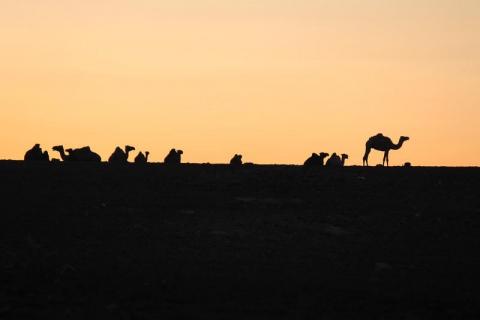
In the past 10 years, Mark Green has made three trips to Jordan for research with the Karak Resources Project (KRP).

In the past 10 years, Mark Green has made three trips to Jordan for research with the Karak Resources Project (KRP).
Mark Green followed his fellow archeologists inside the Bedouin's goat hair tent anchored by rocks and sticks in the Jordan desert. Minutes earlier they had met two Bedouin boys on a ridgetop where the Americans had searched for pottery sherds of previous civilizations.
"We had to use hand gestures to communicate," said Green, Indiana State University's associate vice president for academic affairs and chief research officer. "I could tell at one time they wanted to know what we were doing. One of the guys wanted to invite us for tea, but we didn't know where. They just came over the hillside."
When the group's translator reappeared from his own search for ancient civilizations' remnants, he translated the request and guided them to the Bedouin's tent a mile away.
"The project is fun but also meeting the people is part of it," Green said about his archeological research in that country that borders Israel, Syria, Saudi Arabia and Iraq.
Outside the tent, they took off their shoes before entering and sitting on the brightly colored carpets spread on the desert sand. Soon one of the boys carried in a tray of small glasses filled with sweet mint tea from the separate women's quarters at the back of the tent. The men talked and sipped the scalding tea, carefully positioning their index fingers on the glasses rims and their thumbs on the bottom.
"The guy told us he was struggling. The Bedouins don't want to change their lifestyle," Green said. "The economy there has hurt them."
Before Green journeyed from Terre Haute to Jordan, he'd wondered if the recent death of Osama bin Laden, the Arab Spring and the continuing Iraq war would affect Jordanians perceptions of Americans.
"The politics has hurt them, but we didn't talk politics," Green said. "He couldn't find a market for his sheep and goats."
Due to escalating gas prices in Jordan, buyers found it cheaper to buy imported animals than from local shepherds.
From conversations over cups of steaming mint tea with Jordanians from Bedouins to professionals, Green has become convinced of one thing.
"I think we lose sight of the common person, like you and I, who have the same wants and needs and desires and struggles in life," he said. "They live in a different part of the world, but we're all the same when you get down to it."
In the past 10 years, Green has made three trips (in 2001, 2009 and 2011) to Jordan for research with the Karak Resources Project (KRP). He surveys the landscape to collect field data on water resources, outcrops of building materials, soils and anything else about the landscape to gain further understanding of settlement on Jordan's Karak Plateau. During an early project, he studied hundreds of sites spanning different time periods.
"I frequently found a correlation between large-scale settlement patterns and climates, such as during periods of greater precipitation when settlement expanded into the desert," he said.
His current research focuses on what happened at individual sites such as Mudaybi', which the KRP is excavating. The Moabites who lived there 2,700 years ago felt the need to construct a 7,000-square-meter fort with thick walls, watch towers and gates.
"Obviously there was something going on politically," Green said. "But why did they build there?"
At Mudaybi' they found several cave cisterns close by that could have provided water the inhabitants needed. Many of Jordan's underground cisterns, some of which are 3,000 years old, remain in use today, funneling water from above in the rainy season and holding it until needed in the dry season.
"But what about the hundreds of other sites along the desert? How did they survive? My current work hopes to provide answers to that question," Green said.
During his trip to Jordan at the beginning of July, Green discovered thameelas, small depressions dug by Bedouin that are filled by subsurface springs.
"This season's discovery of thameelas located in arid desert revealed that all is not as it appears," he said. "The Bedouin know how to tap into abundant sources of hidden water where we see only a desolate and barren landscape. I'm sure their ancient ancestors could do the same."
Green's work in Jordan began as his doctoral research in Indiana State's geography department in 2000. With a master's degree in Biblical studies, Green originally wanted to study in Israel. However, no ISU professors doing archaeology work in that part of the world. Upon contacting a former seminary professor, the professor suggested the Karak Resources Project.
"I thought, ‘What's in Jordan?'" said Green, who also uses mapping and satellite imaging in geographic information systems (GIS) in his project. "There's a lot in Jordan. All kinds of Biblical period events took place in Jordan as well."
Green has published papers and presented his research at conferences.
"I enjoy what it does for me professionally in my discipline, but it's also the cultural experience," he said. "I have visited and had a lot of tea with people. People go do tours all the time. They see the sites on postcards and on TV. But when you stay in these small towns, you get to meet the people. It really does change your perspective on things."
Photo: http://isuphoto.smugmug.com/photos/i-TMVpZng/0/L/i-TMVpZng-L.jpg
Mark Green in Jordan with a thameela his group found. ISU/Courtesy Photo
http://isuphoto.smugmug.com/photos/i-Kxdh6h3/0/L/i-Kxdh6h3-L.jpg
Bedouins invited the researchers for tea. ISU/Courtesy photo
http://isuphoto.smugmug.com/photos/i-w6JVWGS/0/L/i-w6JVWGS-L.jpg
Camels at sunrise in Jordan. ISU/Courtesy Photo
http://isuphoto.smugmug.com/photos/i-7rqDjR2/0/L/i-7rqDjR2-L.jpg
A shepherd moves his flock in Jordan. ISU/Courtesy photo
Contact: Mark Green, Indiana State University, associate vice president for academic affairs and chief research officer, at 812-237-3572 or Mark.Green@indstate.edu
Writer: Jennifer Sicking, Indiana State University, associate director of media relations, at 812-237-7972 or Jennifer.Sicking@indstate.edu